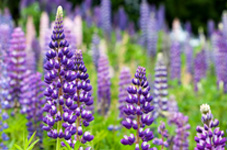
The Israeli Lupine
A gorgeous native wildflower of the Land of Israel, the Lupine was Rebbe Shimon bar Yochai's amazing tool that he used to purify ancient Tiberius…

Everything in the land of Israel is exquisite, especially the wildflowers and native plants. One of my favorite wildflowers is the Israeli Lupine, a gorgeous intensely blue flower with white spots at the base. As a legume, the lupine plant produces a pod that contains three to five cream-colored seeds known as the turmus in Hebrew. The plant itself is highly toxic. If sheep or cows are allowed to graze in a meadow where lupines grow, they could likely become very sick. Since the seeds are supercharged with protein, they could create flatulence in the animal’s rumen (stomach), causing it to bloat. The lupine bean is both extremely hard and bitter as well.
Our ancestors in the land of Israel knew how to overcome the toxicity and bitterness of the Lupine seed and take advantage of its wealth of protein and nutrient value. The Gemara says that Lupine beans should be boiled seven times. According to Tractate Beitza, our ancestors used to eat seven-times-boiled lupine seeds, which resemble lima beans and were sweetened with honey or sugar then served as a desert. Yet the Gemara in Tractate Shabbat refers to lupine beans as poor man’s food. At any rate, since the Israeli Lupine is  a rare and protected specie, it’s against the law to pick them in Israel, so we don’t eat them nowadays. That doesn’t stop Arab vendors from selling them on the side of the roads in the Shomron and in the Jordan Valley.
a rare and protected specie, it’s against the law to pick them in Israel, so we don’t eat them nowadays. That doesn’t stop Arab vendors from selling them on the side of the roads in the Shomron and in the Jordan Valley.
You’ll find Lupines growing in well-aerated and drained soils. They especially thrive in the volcanic soils of the northern Shomron and the sandy soils of the Sharon plain and the northern Negev. They flower mostly in late February and March, at the termination of Israel’s rainy season. One of the nicest surprises that a hiker or backpacker can have in the land of Israel is to encounter a field full of blue-and-white Lupines – you’d think you just walked into Heaven…
The Midrash in Bereishit Raba tells a wonderful story about the Lupines. After Rebbe Shimon bar Yochai spent his thirteen years in a cave, he immersed in the Sea of Galilee. He was so thankful to the people of Tiberius (which is located on the shore of the Sea of Galilee), that he wanted to do some special favor for them. He asked them what they needed. The people of Tiberius told Rebbe Shimon that since there were so many uncharted burial caves in the vicinity, the Cohanim – the priestly tribe whose members are forbidden to come within four cubits of a grave or a dead person – did not know which paths they could take without being rendered ritually contaminated. Rebbe Shimon did an amazing thing: he planted Lupine seeds in the areas that were suspicious of having graves underneath. The Midrash tells us that wherever there were dead buried below the surface of a particular plot of land, the Lupines germinated and grew. Rebbe Shimon then clearly marked these places as unsuitable for a priestly use as a thoroughfare.
Lupines grow tenaciously. When the seed pods mature and dry, they pop open like a rifle crack, spreading the seeds all over. They are also heliotropic, meaning that they follow the sun. In the morning, their leaves face east, ready to greet the sun. In the late afternoon, the leaves face the west.
There’s nothing like our native blue-and-white Lupine flowers to fuel one’s love of our cherished and beautiful homeland, which eagerly anticipated the return of all her sons and daughters from exile, speedily and in our days, amen.











12/10/2012
What a tour guide! My husband and I are coming to Israel soon. Would Tal Rotem be available as a tour guide? His love of Eretz Yisroel and his knowledge of chaza"l is amazing.
12/10/2012
My husband and I are coming to Israel soon. Would Tal Rotem be available as a tour guide? His love of Eretz Yisroel and his knowledge of chaza"l is amazing.